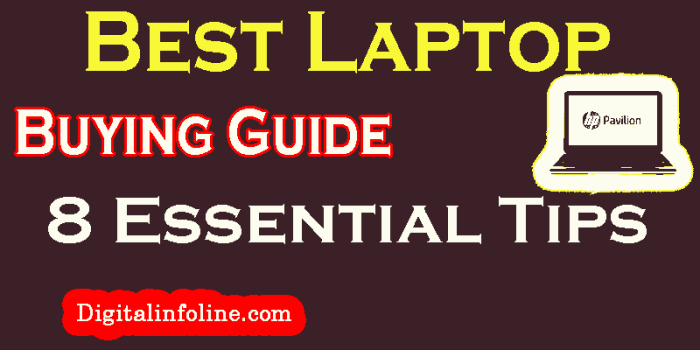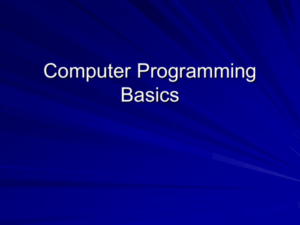
Welcome to the Computer buying guide, where we embark on a glorious quest through the land of tech! Whether you’re looking for a sturdy desktop to conquer spreadsheets or a sleek laptop to impress at the coffee shop, we’ve got you covered. From understanding the mystical differences between desktops, laptops, and tablets to unraveling the secrets of gaming rigs and workstations, this guide promises to be a delightful adventure into the world of computing.
But wait, there’s more! We’ll dive into key specifications that make your heart race, explore budgeting strategies that won’t leave your wallet in tears, and even dish out hot tips on snagging the best deals. So buckle up, fellow tech traveler; we’re about to unlock the treasure chest of computer knowledge!
Understanding Computer Types

In the vast universe of technology, computers come in various shapes and sizes, each tailored for different needs and lifestyles. Whether you’re a casual web surfer, a hardcore gamer, or a professional designer, there’s a computer that’s just perfect for you. Let’s dive into the wonderful world of computer types and unravel the delightful differences.
Differences Between Desktops, Laptops, and Tablets
When it comes to computers, the first distinction we encounter lies in their form factors. Each type has its unique flair and functionality.
- Desktops: The quintessential home or office companion, desktops pack a punch with power and upgradeability. They typically feature larger screens, full-sized keyboards, and more powerful components, making them ideal for gaming, multimedia editing, and heavy multitasking. Just remember, they don’t make great travel buddies!
- Laptops: The champions of portability, laptops offer the perfect blend of performance and convenience. With built-in batteries, they allow you to work from different locations—be it your couch, a coffee shop, or even the bathroom (we don’t judge!). However, they might not match the raw power of desktops, particularly for resource-heavy tasks.
- Tablets: The sleek and stylish devices that have taken the world by storm! Tablets are lightweight, portable, and offer touch-screen functionality, making them great for casual browsing, reading, and entertainment. But, when it comes to serious work, they might leave you longing for a physical keyboard and a bit more processing power.
Overview of Gaming Computers and Workstations
Not all computers are created equal, especially when it comes to gaming and professional workloads. Let’s explore the robust features that distinguish gaming computers from workstations.
- Gaming Computers: Designed for adrenaline-pumping action, gaming PCs are equipped with high-performance graphics cards, fast processors, and ample RAM to handle the most demanding games. They often come with flashy RGB lighting, because why not make gaming a full-on disco party?
- Workstations: The unsung heroes of professional work, workstations are built for tasks such as 3D rendering, video editing, and software development. They prioritize stability and reliability over flashy designs, typically featuring powerful CPUs, large amounts of RAM, and specialized hardware tailored for professional applications. Think of them as the business suits of the computer world—efficient but a tad boring.
Advantages and Disadvantages of All-in-One PCs
All-in-One PCs have carved out their niche in the computer market, combining the elegance of a sleek design with the functionality of a traditional desktop. However, they come with their own set of pros and cons.
“All-in-One PCs: where style meets substance, but sometimes falls short on upgradeability.”
- Advantages:
- Space-saving: All-in-One PCs eliminate the need for a separate tower, freeing up valuable desk space for that oversized mug collection.
- Minimalist Design: They offer a clean and modern look, making them perfect for aesthetically-conscious users who want to keep clutter at bay.
- Integrated Components: Most come with built-in webcams and speakers, allowing you to jump into video calls without scrambling for accessories.
- Disadvantages:
- Limited Upgrade Options: Unlike traditional desktops, upgrading components can be a hassle, often requiring professional assistance.
- Heat Management: All-in-One PCs can sometimes struggle with heat dissipation due to compact designs, which can impact performance.
- Pricey: The sleek design often comes with a higher price tag compared to traditional setups with similar specs—ah, the price of beauty!
Key Specifications to Consider
When embarking on your computer shopping journey, it’s crucial to sift through the myriad of specifications that can make or break your digital experience. Think of it as picking the right ingredients for a gourmet meal; you wouldn’t want to skimp on the essentials, lest you end up with a recipe for disappointment. Let’s dive into the key specs you need to keep your eyes peeled for, ensuring that your new computer is both efficient and a joy to use.
Importance of CPU, RAM, and Storage Types
The three pillars of computer performance are the CPU, RAM, and storage types, each playing a unique role in how smoothly your computer runs.
- CPU (Central Processing Unit): Often referred to as the brain of the computer, the CPU determines how quickly tasks are processed. A high-end CPU can handle demanding applications like video editing or gaming, while a weaker one might leave you twiddling your thumbs.
- RAM (Random Access Memory): This is the short-term memory of your computer. More RAM allows your machine to run multiple applications simultaneously without turning into a sluggish snail. Think of it as the difference between a spacious office and a cluttered desk—room to work means faster results!
- Storage Types: The type of storage you choose can greatly affect performance. Solid State Drives (SSDs) are like the speedsters of the storage world, offering quicker boot times and faster file access, while traditional Hard Disk Drives (HDDs) provide more storage for less cash, albeit at a slower pace.
Significance of Graphics Cards
Graphics cards, or GPUs (Graphics Processing Units), are the unsung heroes of visual performance. They transform the ones and zeros of data into the stunning visuals we often take for granted. A robust graphics card can make all the difference, especially for gamers or creative professionals.
- Gaming Experience: For those who enjoy a little pixelated adventure, a powerful GPU can ensure smooth gameplay, high frame rates, and eye-popping graphics, especially in immersive environments like virtual reality.
- Content Creation: If you dabble in graphic design, video editing, or 3D modeling, investing in a solid graphics card is essential. It allows for rendering high-quality images and videos without turning your computer into a hot mess.
- Future Proofing: A good graphics card will keep you ahead of the curve as software demands increase. It’s like upgrading your tires before a road trip; you want to ensure a smooth ride now and in the future!
Budgeting for Your Computer

When it comes to buying a computer, your wallet will often dictate your destiny. Whether you’re a gaming guru or a casual browser, understanding how to allocate your funds is crucial. In this section, we’ll break down the expected costs for different computer types, dissect brand pricing strategies, and explore financing options to help you snag the best deal without breaking the bank.
Cost Breakdown by Computer Type
Understanding the costs associated with different types of computers can prevent a major budgetary headache. Here’s a breakdown that helps you gauge how much to set aside for your future digital companion:
| Computer Type | Expected Cost Range | Key Features |
|---|---|---|
| Laptop | $300 – $2,500 | Portability, built-in battery, varying performance. |
| Desktop | $400 – $3,000 | Customizability, larger screens, typically more power. |
| Gaming PC | $800 – $5,000+ | High performance, advanced graphics, specialized cooling. |
| All-in-One | $500 – $2,000 | Space-saving design, integrated components. |
Remember, the cost can vary significantly based on brand, specifications, and sales events!
Brand Pricing Strategies
Not all computer brands are created equal; some have pricing strategies that will make your wallet weep, while others are known for budget-friendly options without sacrificing quality. Here’s a look at how various brands stack up against each other for similar configurations:
| Brand | Average Price for Mid-Range Laptop | Price Variability |
|---|---|---|
| Dell | $700 | Moderate, often holds sales. |
| HP | $650 | Low to moderate, frequent promotions. |
| Apple | $1,200 | High, premium pricing strategy. |
| Acer | $600 | Low, aggressive pricing. |
Dive into brand comparisons for potential savings; some brands are like that friend who always has discounts!
Financing Options and Best Deals
Budgeting for a computer doesn’t always mean you need to dip into your savings. Various financing options are available that can ease the burden of large purchases, making it easier to walk out with your new tech buddy. Here’s a look at popular financing methods and where you might find the best deals:
- Credit Cards: Many offer 0% APR for a limited time on new purchases, just be careful not to turn that into a long-term loan.
- Retailer Financing Programs: Stores like Best Buy or Dell often have their own financing options with special promotions.
- Buy Now Pay Later Services: Services like Afterpay or Klarna let you split the cost over several payments, making it feel like you’re just renting the computer — until you own it!
- Student Discounts: If you’re a student, take advantage of discounts from brands like Apple and Microsoft, because education should come with a side of savings.
Always compare financing options; the right choice can keep your finances from going haywire!
Epilogue
As we reach the end of our exhilarating journey through the Computer buying guide, remember that the perfect computer is out there just waiting to be discovered by you! Equipped with the wisdom of specifications, budget strategies, and brand comparisons, you’re now ready to make a choice that will have you dancing with joy. Whether you’re a casual browser or a hardcore gamer, may your new computer be everything you dreamed of and more—happy shopping!
Question & Answer Hub
What is the difference between RAM and storage?
RAM is like your desk space—more allows you to work on multiple tasks at once, while storage is like your filing cabinet, keeping all your files safe and sound.
Do I really need a dedicated graphics card?
If you’re into gaming or graphic design, then yes, a dedicated graphics card is your best friend! Otherwise, integrated graphics might just do the trick.
How often should I upgrade my computer?
It depends on usage! If your computer starts slowing down like a tortoise in molasses, it might be time to consider an upgrade.
Are refurbished computers worth it?
Absolutely! Like finding a diamond in the rough, refurbished computers can be great deals, just make sure to buy from reputable sellers.
What’s the best time of year to buy a computer?
Look out for big sales during back-to-school season, Black Friday, and post-holiday clearances—these are the magical times for tech deals!





